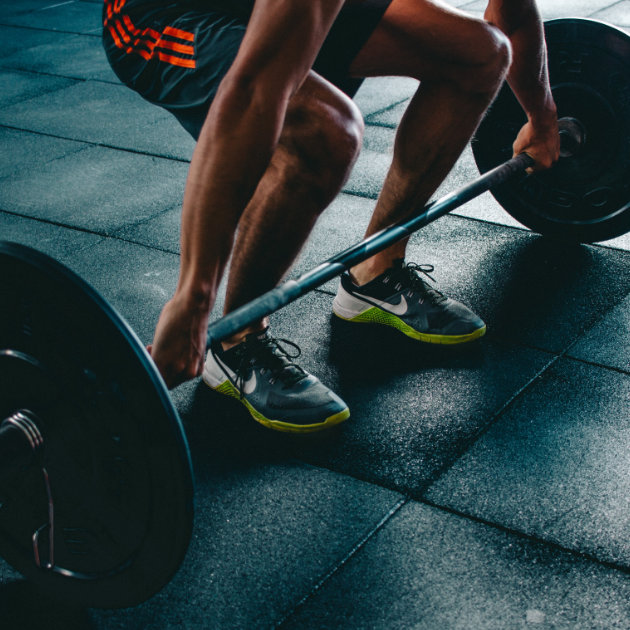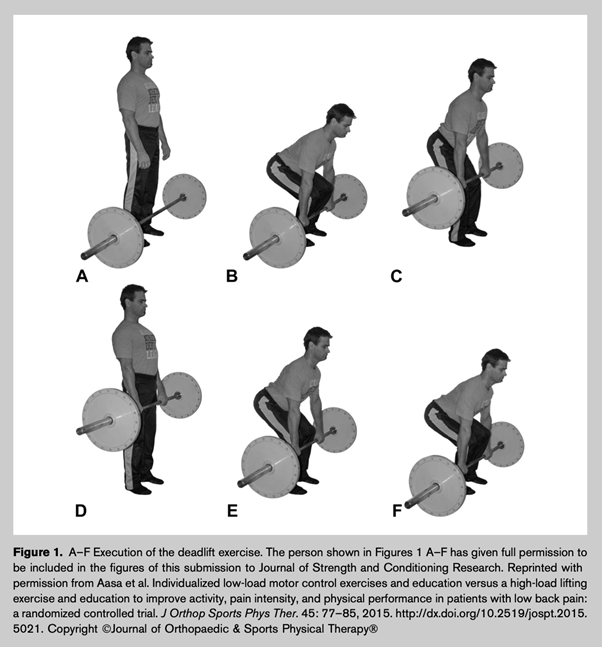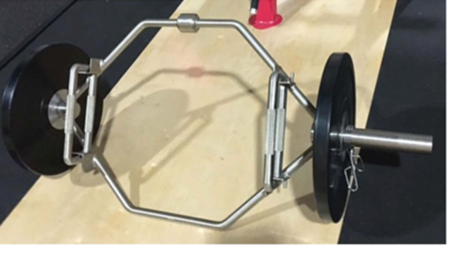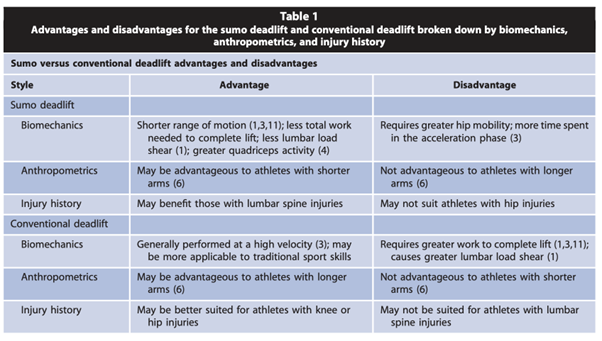Regaining Confidence with the Conventional Barbell Deadlift

The Barbell Deadlift is one of the most common exercises performed in the gym. It incorporates a movement pattern that we incorporate into every day to lift items from the floor. For many individuals it can be an exercise that they become sore during or after, avoid due to past injury or don’t feel they can do due to pain or fear of future pain. Whilst it is by no means necessary for everyone to deadlift in the gym, it is an exercise that has numerous benefits. Here we discuss some alternative options to the deadlift and strategies that assist getting comfortable performing the deadlift.
Conventional Barbell Deadlift
The deadlift possesses several unique mechanical characteristics that can improve functional strength and movement efficiency. The mechanical characteristics of the deadlift, include the ability to recruit significant muscle groups, at high contraction rates making it great for developing lower limb strength power (1). It works the quadriceps, glutes, hamstring and muscles of the trunk and lower back. It has been used to improve vertical jump performance, rate of muscular force production (2) and bone mineral density (3). Conventional barbell deadlifts are often instructed as a series of steps
- Approach the barbell with shins against the bar
- Squat down and grab the barbell outside knee width
- Keep your back flat (neutral) reach your hips back
- Create tension by tightening through your arms and brace so shoulders are set over the bar
- Push through the floor to lift the bar from the ground keeping the barbell close to you as you ascend
There are many challenges faced by the deadlift, even the name itself adds to the intimidation for some people. Whilst there are many options to work towards weighted barbell deadlifts, sometimes the best rehabilitation exercise is the barbell deadlift itself with the right coaching points, encouragement and reassurance. If someone has mild pain with the exercise but is not apprehensive then looking at the technique of the exercise is an essential first step. Common areas of improvement include; incorrect starting position, shoulders not over the bar, bending arms during the lift, losing braced position, hyperextending at the top of the lift, bar path being too far away from the body. Our lower backs are robust and many people can often perform heavy and regular deadlifts with one or more of these faults without pain or soreness. Working on cues to change common faults can however be an option to help someone lift with increased ease, greater confidence and less or no pain. So step 1 in working back to deadlift is looking at your deadlift and finding a comfortable weight that can be performed with comfortable technique.

Hex Bar Deadlift
The hexagonal bar or trap bar deadlift is a common weightlifting exercise. Originally trapezoidal in shape and called the trap bar deadlift now the more commonly used hexagonal shaped bar is the most common variation of the deadlift (4). Hex Bars have also incorporated high and low handle positions to produce several potential benefits. This includes a more advantageous lift position for those with mobility restrictions or morphology that enables them to get to the bottom position of a conventional deadlift. There is greater work completed by the knee extensors (quadriceps) and less stress on the lower back with lower moment arms at the lumbar spine, hip, knee, and ankle related to the lifting position provided by the hex bar design (4, 5). This enables individuals choosing the low and high bar deadlift to achieve greater peak power, peak velocity, and peak and mean force when compared with the 1RM conventional deadlift (4, 5, 6).
The Hex Bar deadlift creates a great option to reproduce a similar movement pattern to the conventional barbell deadlift with less on the lower back and more comfortable bottom position for many lifters. This also acts as a tool for exposure to heavier weights with greater comfort during lifts and higher peak forces achievable. As an alternative to the hex bar dumbbells from blocks (rather than lowering all the way to the floor) can also be used to similar effect.

Figure 2: Hexagonal Bar with high and low handles (7)
Sumo Deadlift
A sumo deadlift is another deadlift variation that involves a wider stance and feet turned out. The bar is gripped inside the knees instead of outside the knees during the conventional deadlift. When compared to a conventional barbell deadlift and sumo deadlift has greater quadriceps recruitment, decreased hamstring recruitment and a more vertical torso (8, 9). For many individuals struggling to return to deadlift having a more vertical torso may facilitate more comfort and confidence. The following table is from Belcher 2017 (9) illustrating the advantages and disadvantages of the sumo and conventional deadlift (8, 10-12).

Lower Body Lifts
In addition to practising variation of the deadlift such as the sumo or hex bar deadlift other lower body strength exercises can be valuable to return to the deadlift. Squats, split squats and hip thrusts can all have value to aid returning to deadlift. The barbell front squat or back squat can provide a strength training stimulus for the lower limb muscles and practice of ‘bracing technique’ with an alternate form of stress on the body. These movement patterns are primarily vertical compared to horizontal forces during the deadlift. Similarly the hip thrust is a large multi joint movement which produces greatest recruitment of gluteus maximus (13). Performing other exercises that strengthen key lower body muscle groups can help complement returning to a conventional deadlift.
Confidence and Feeling Strong
It is a common misconception that back pain is related to a ‘weak core’ (14). Understanding that weakness is not always an underlying problem for pain during a deadlift can enhance one’s self efficacy. This means that performing hours of core exercises is not albeit necessary to perform deadlifts. Many individuals do enjoy ‘feeling strong’ and trunk exercises can be a useful method to gain self-confidence alongside encouragement and education from the appropriate health professional. Accessory ‘core’ exercises such as plank variations, side planks, palofpress, GHD back extensions, ab rollouts and farmers carry (to name but a few) can be used to improve strength and help gain confidence. There is immense value in being and feeling strong but it is important to appreciate that you need to do them because your back is weak or unstable.
Repetition
Like any skill or movement pattern, learning takes time. Practising with a lighter weight or just the barbell is an important part of skill acquisition. Utilise an appropriate health professional and use different forms of feedback to help consolidate your technique.

Lewis Craig (APAM)
POGO Physiotherapist
Masters of Physiotherapy
Featured in the Top 50 Physical Therapy Blog
References
- Berglund, L, Aasa, B, Hellqvist, J, Michaelson, P, and Aasa, U. Which patients with low back pain benefit from deadlift training? J Strength Cond Res 29(7): 1803–1811, 2015
- Vecchio, L. D., Daewoud, H., & Green, S. (2018). The health and performance benefits of the squat, deadlift. and bench press. MOJ Yoga & Physical Therapy, 3(2), 40-47.
- Almstedt HC, Canepa JA, Ramirez DA, et al. Changes in bone mineral density in response to 24 weeks of resistance training in college‒age men and women. J Strength Cond Res. 2011;25(4):1098‒1103.
- Swinton, P. A., Stewart, A., Agouris, I., Keogh, J. W., & Lloyd, R. (2011). A biomechanical analysis of straight and hexagonal barbell deadlifts using submaximal loads. The Journal of Strength & Conditioning Research, 25(7), 2000-2009.
- Camara KD, Coburn JW, Dunnick DD, Brown LE, Galpin AJ, and Costa PB. An examination of muscle activation and power characteristics while performing the deadlift exercise with straight and hexagonal barbells. J Strength Cond Res 30: 1183–1188, 2016.
- Lockie RG, Moreno MR, Lazar A, Risso FG, Tomita TM, Stage AA, Birmingham- Babauta SA, Torne IA, Stokes JJ, Giuliano DV, Davis DL, Orjalo AJ, and Callaghan SJ. The one-repetition maximum mechanics of a high-handle hexagonal bar deadlift compared to a conventional deadlift as measured by a linear position transducer. J Strength Cond Res 2017. doi:10.1519/ JSC.0000000000001781. Epub ahead of print.
- Lockie, R. G., & Lazar, A. (2017). Exercise technique: applying the hexagonal bar to strength and power training. Strength & Conditioning Journal, 39(5), 24-32.
- Escamilla, RF, Francisco, AC, Fleisig, GS, Barrentine, SW, Welch, CM, Kayes, AV, Speer, KP, and Andrews, JR. A three-dimensional biomechanical analysis of sumo and conventional style deadlifts. Med Sci Sports Exerc 32: 1265-1275, 2000.
- Belcher, D. (2017). The sumo deadlift. Strength & Conditioning Journal, 39(4), 97-104.
- Cholewicki J, McGill SM, and Norman RW. Lumbar spine loads during the lifting of extremely heavy weights. Med Sci Sports Exerc 23: 1179–1186, 1991
- Nuzzo JL, McCaulley GO, Cormie P, Cavill MJ, and McBride JM. Trunk muscle activity during stability ball and free weight exercises. J Strength Cond Res 22: 95– 102, 2008.
- Hales M. Improving the deadlift: Understanding biomechanical constraints and physiological adaptations to resistance exercise. Strength Cond J 32: 44–51, 2010.
- Andersen, V., Fimland, M. S., Mo, D. A., Iversen, V. M., Vederhus, T., Hellebø, L. R. R., … & Saeterbakken, A. H. (2018). Electromyographic comparison of barbell deadlift, hex bar deadlift, and hip thrust exercises: A cross-over study. The Journal of Strength & Conditioning Research, 32(3), 587-593.
- O’Sullivan, P. B., Caneiro, J. P., O’Sullivan, K., Lin, I., Bunzli, S., Wernli, K., & O’Keeffe, M. (2020). Back to basics: 10 facts every person should know about back pain. British journal of sports medicine, 54(12), 698-699.








